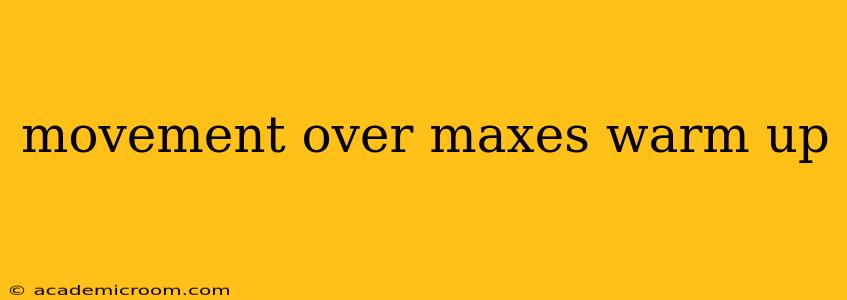Many lifters focus solely on hitting personal records (maxes) in the gym, neglecting the crucial role of a proper warm-up. However, prioritizing movement over maxes during your warm-up can dramatically improve your performance, reduce injury risk, and enhance muscle growth. This approach emphasizes quality movement and muscle activation before tackling heavy weights, shifting the focus from simply reaching a specific weight to preparing your body for optimal performance.
This article will delve into the benefits of a movement-focused warm-up, detailing specific exercises and strategies to improve your training experience. We'll also address frequently asked questions surrounding warm-up routines.
Why Movement Matters More Than Maxing Out During Warm-ups
The primary goal of a warm-up isn't to exhaust yourself with heavy weights before your main lifts. Instead, it's to prepare your body for the demands of your workout. Focusing on movement allows you to:
- Increase blood flow: Gentle movement increases blood flow to your muscles, delivering oxygen and nutrients necessary for optimal performance.
- Improve muscle activation: Dynamic stretches and mobility exercises activate your muscles and nervous system, priming them for heavier lifts.
- Enhance range of motion: Proper warm-ups improve joint mobility and flexibility, leading to better technique and reduced injury risk.
- Boost mental preparation: A focused warm-up helps you mentally prepare for your workout, improving concentration and reducing anxiety.
- Promote hypertrophy: A well-structured warm-up incorporating lighter weight sets can contribute to muscle growth by initiating muscle protein synthesis.
What Should My Warm-up Include? (Movement-Focused Approach)
Your warm-up should be tailored to your specific workout. However, a general framework includes:
- General Warm-up (5-10 minutes): Light cardio, such as jogging, jumping jacks, or cycling, to elevate your heart rate and increase blood flow.
- Dynamic Stretching (5-10 minutes): Focus on movements that mimic the exercises you'll be performing, such as arm circles, leg swings, torso twists, and dynamic stretches for your targeted muscle groups. Avoid static stretching (holding a stretch) during your warm-up.
- Specific Warm-up (10-15 minutes): This phase involves performing the exercises you'll be doing in your workout but with lighter weight and lower repetitions. This allows you to gradually increase the load and prepare your body for heavier sets. Consider using a weight that allows for 15-20 controlled repetitions with good form.
How Many Sets and Reps Should I Do During My Warm-up?
The number of sets and repetitions during your warm-up will depend on the exercise and your individual needs. A common approach is to use a "pyramid" system, gradually increasing the weight and decreasing the repetitions with each set. For example:
- Squats: 1 set of 15 reps with bodyweight, 1 set of 10 reps with a light weight, 1 set of 5 reps with a moderate weight.
- Bench Press: 1 set of 15 reps with an empty bar, 1 set of 10 reps with a light weight, 1 set of 5 reps with a moderate weight.
Is it Okay to Skip the Warm-up?
No, skipping your warm-up is strongly discouraged. A proper warm-up is crucial for injury prevention and optimal performance. Neglecting this crucial step significantly increases your risk of muscle strains, tears, and other injuries. Think of it as an investment in your long-term training success.
What's the Difference Between a Dynamic and Static Stretch?
- Dynamic stretches involve movement. Examples include arm circles, leg swings, and torso twists. These are ideal for warming up.
- Static stretches involve holding a stretch for a period of time (typically 15-30 seconds). These are better suited for after your workout to improve flexibility and recovery.
How Long Should My Warm-up Last?
The ideal warm-up duration varies depending on your workout intensity and the exercises involved. A general guideline is to allocate 15-30 minutes for a thorough warm-up. Don't rush this crucial phase!
Can I Use a Movement-Focused Warm-up for All Exercises?
Yes, the principles of a movement-focused warm-up apply to all exercises, whether compound movements (squats, deadlifts, bench press) or isolation exercises (bicep curls, triceps extensions). Always prioritize controlled movement and proper form throughout your warm-up.
By prioritizing movement over maxes in your warm-up, you’ll build a stronger, more resilient body, and ultimately achieve better results in your training. Remember, consistency and quality are key. A well-structured warm-up isn't just a pre-requisite for lifting; it's a crucial component of a successful and injury-free training journey.
